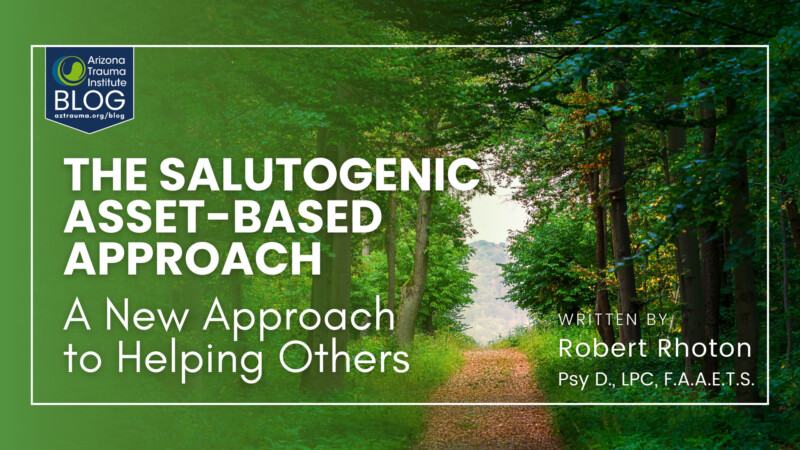A New Approach to Helping Others
In the early 1970s, cognitive psychologist George Kelly developed the idea of expectancy, which posits that WE TEND TO GET MORE OF WHAT WE FOCUS ON. This theory has important implications for those of us in the helping professions. All too often, we focus on the problems and weaknesses of those we are trying to help—but Kelly’s theory suggests that this focus does not actually lead to transformation. If we want to help others grow and change, we need to adopt a new approach—one that focuses on human potential and assets rather than weaknesses. This approach is known as the salutogenic asset-based approach.
The salutogenic asset-based approach is founded on the idea that every person has unrealized potential, capacities, competencies, and assets that can be used to promote health and well-being. This approach asks not “What is wrong with you?” but rather “What do you need in order to thrive?” When we shift our focus from problems to assets, we open new possibilities for growth and change.
The asset-based approach is a way of thinking and acting that focuses on what individuals and communities have to build upon, rather than what they lack. When we take an asset-based approach with others, we recognize that everyone has untapped potential and abilities that can be mobilized to achieve desired goals. This doesn’t mean that we ignore challenges or areas for improvement. It just means that we start from a place of strengthening what assets they already possess instead of weakness.
![]()
Here are six reasons why the salutogenic asset-based approach is so effective:
1.) IT LEADS TO GREATER ENGAGEMENT
When we focus on problems, we inadvertently create feelings of shame, inadequacy, and hopelessness—none of which are conducive to engagement. On the other hand, when we focus on assets and competency, we create a sense of hope and possibility. People are much more likely to engage in the process of change when they feel hopeful and confident in their ability to make positive changes.
2.) IT FACILITATES INTRINSIC MOTIVATION.
Intrinsic motivation comes from within oneself—it is not externally imposed or controlled. The idea that a therapist or teacher can instruct motivation into a person is a fallacy. When we focus on problems, we foster a sense of helplessness in those we are trying to help; however, when we focus on assets, competencies, and potentials, we empower people to take ownership of their own growth and change. Intrinsic motivation is key to sustainable change because it cannot be taken away or turned off—unlike extrinsic motivation, which often wanes over time.
3.) IT PROMOTES POSITIVE EMOTIONS.
Focusing on problems creates negative emotions like sadness, anger, shame, despair, and anxiety. On the other hand, focusing on strengths creates positive emotions like happiness, pride, and optimism. Not only do positive emotions feel good in the moment, but they also have lasting effects on our physical and mental health. Positive emotions bolster our immune systems, reduce stress levels, and improve overall well-being.
4.) IT BUILDS RELATIONSHIPS OF TRUST AND RESPECT.
When we focus on what’s right with people instead of what’s wrong, they feel seen and valued. This creates a foundation of trust that allows for open communication and collaboration.
5.) IT GENERATES CREATIVE SOLUTIONS.
When we’re focused on finding problems, we usually only see more problems. But when we’re focused on finding assets and strengths, we open ourselves up to new possibilities and solutions.
6.) IT LEADS TO LASTING CHANGE.
Focusing on deficits only leads to more deficit thinking. But when we focus on assets, individuals and whole communities can begin to think and act in new ways that lead to lasting positive change.
![]()
If you want to truly help others grow and change, ditch the traditional deficit-based approach in favor of the salutogenic asset-based approach.
This strength-focused approach leads to greater engagement, facilitates intrinsic motivation, and promotes positive emotions—all of which are essential for sustainable change. Investing your time and energy in identifying and building upon strengths will pay off tenfold in terms of promoting health and well-being in those you serve.
The next time you’re tempted to focus on what’s wrong with someone or something, remember the power of an asset-based approach. By focusing on what’s right instead of what’s wrong, you can build relationships based on trust and respect, generate creative solutions, and create lasting change in yourself and in those around you. Try it today!
![]()

Written by Robert Rhoton Psy D., LPC, F.A.A.E.T.S.
Dr. Robert Rhoton, CEO of Arizona Trauma Institute and President at the Trauma Institute International possesses a rich history of experience in the mental health field.



